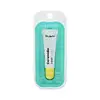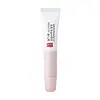What's inside
What's inside
 Key Ingredients
Key Ingredients

 Benefits
Benefits

 Concerns
Concerns

 Ingredients Side-by-side
Ingredients Side-by-side

Phytosteryl/Isostearyl/Cetyl/Stearyl/Behenyl Dimer Dilinoleate
Skin ConditioningPentaerythrityl Tetraethylhexanoate
EmollientDiisostearyl Malate
EmollientHydrogenated Polyisobutene
EmollientEthylhexyl Stearate
EmollientCeresin
Emulsion StabilisingMethyl Hydrogenated Rosinate
PerfumingTribehenin
EmollientSilica Dimethyl Silylate
EmollientPolymethylsilsesquioxane
Vp/Hexadecene Copolymer
Ethylene/Propylene/Styrene Copolymer
Butylene/Ethylene/Styrene Copolymer
Ceramide NP
Skin ConditioningCitrus Aurantium Bergamia Fruit Oil
MaskingDehydroacetic Acid
PreservativeHippophae Rhamnoides Oil
EmollientPelargonium Graveolens Flower Oil
MaskingSalvia Officinalis Oil
MaskingPogostemon Cablin Leaf Oil
MaskingWater
Skin ConditioningDipropylene Glycol
HumectantHydrogenated Lecithin
EmulsifyingCetyl-Pg Hydroxyethyl Palmitamide
Skin ConditioningPropanediol
SolventGlyceryl Stearate
EmollientSodium Hyaluronate Crosspolymer
HumectantCeramide Ns
Skin ConditioningHydrolyzed Glycosaminoglycans
HumectantGlycerin
HumectantSodium Hyaluronate
HumectantCeramide AP
Skin ConditioningCeramide As
Skin ConditioningBenzyl Glycol
SolventHydrolyzed Hyaluronic Acid
HumectantCholesterol
EmollientEthylhexylglycerin
Skin ConditioningCeramide EOP
Skin ConditioningHyaluronic Acid
HumectantRaspberry Ketone
MaskingPhytosteryl/Isostearyl/Cetyl/Stearyl/Behenyl Dimer Dilinoleate, Pentaerythrityl Tetraethylhexanoate, Diisostearyl Malate, Hydrogenated Polyisobutene, Ethylhexyl Stearate, Ceresin, Methyl Hydrogenated Rosinate, Tribehenin, Silica Dimethyl Silylate, Polymethylsilsesquioxane, Vp/Hexadecene Copolymer, Ethylene/Propylene/Styrene Copolymer, Butylene/Ethylene/Styrene Copolymer, Ceramide NP, Citrus Aurantium Bergamia Fruit Oil, Dehydroacetic Acid, Hippophae Rhamnoides Oil, Pelargonium Graveolens Flower Oil, Salvia Officinalis Oil, Pogostemon Cablin Leaf Oil, Water, Dipropylene Glycol, Hydrogenated Lecithin, Cetyl-Pg Hydroxyethyl Palmitamide, Propanediol, Glyceryl Stearate, Sodium Hyaluronate Crosspolymer, Ceramide Ns, Hydrolyzed Glycosaminoglycans, Glycerin, Sodium Hyaluronate, Ceramide AP, Ceramide As, Benzyl Glycol, Hydrolyzed Hyaluronic Acid, Cholesterol, Ethylhexylglycerin, Ceramide EOP, Hyaluronic Acid, Raspberry Ketone
Hydrogenated Polyisobutene
EmollientMicrocrystalline Wax
Emulsion StabilisingPentaerythrityl Tetraisostearate
EmollientButyrospermum Parkii Butter
Skin ConditioningDextrin Palmitate/Ethylhexanoate
EmulsifyingGlycerin
HumectantPolyethylene
AbrasiveDehydroacetic Acid
PreservativeDimethicone
EmollientDisteardimonium Hectorite
StabilisingButylene Glycol
HumectantSorbitan Isostearate
EmulsifyingCamellia Japonica Seed Oil
EmollientPanax Ginseng Root Water
MaskingAngelica Acutiloba Root Extract
Skin ConditioningOphiopogon Japonicus Root Extract
Skin ConditioningBupleurum Chinense Root Extract
AstringentOzokerite
Emulsion StabilisingHc Red No. 8
CI 77491
Cosmetic ColorantCaprylic/Capric Triglyceride
MaskingTocopherol
AntioxidantTocopheryl Acetate
AntioxidantTriethylhexanoin
MaskingTitanium Dioxide
Cosmetic ColorantPolyglyceryl-2 Diisostearate
EmulsifyingPolyglyceryl-2 Dipolyhydroxystearate
Skin ConditioningPolyglyceryl-2 Triisostearate
EmulsifyingPolyhydroxystearic Acid
EmulsifyingPropylene Carbonate
SolventHydrolyzed Collagen
EmollientParfum
MaskingHydrogenated Polyisobutene, Microcrystalline Wax, Pentaerythrityl Tetraisostearate, Butyrospermum Parkii Butter, Dextrin Palmitate/Ethylhexanoate, Glycerin, Polyethylene, Dehydroacetic Acid, Dimethicone, Disteardimonium Hectorite, Butylene Glycol, Sorbitan Isostearate, Camellia Japonica Seed Oil, Panax Ginseng Root Water, Angelica Acutiloba Root Extract, Ophiopogon Japonicus Root Extract, Bupleurum Chinense Root Extract, Ozokerite, Hc Red No. 8, CI 77491, Caprylic/Capric Triglyceride, Tocopherol, Tocopheryl Acetate, Triethylhexanoin, Titanium Dioxide, Polyglyceryl-2 Diisostearate, Polyglyceryl-2 Dipolyhydroxystearate, Polyglyceryl-2 Triisostearate, Polyhydroxystearic Acid, Propylene Carbonate, Hydrolyzed Collagen, Parfum
Ingredients Explained
These ingredients are found in both products.
Ingredients higher up in an ingredient list are typically present in a larger amount.
Dehydroacetic Acid is fungicide and bactericide. It is used as a preservative in cosmetics. Preservatives help elongate the shelf life of a product.
Dehydroacetic Acid is not soluble in water.
Glycerin is already naturally found in your skin. It helps moisturize and protect your skin.
A study from 2016 found glycerin to be more effective as a humectant than AHAs and hyaluronic acid.
As a humectant, it helps the skin stay hydrated by pulling moisture to your skin. The low molecular weight of glycerin allows it to pull moisture into the deeper layers of your skin.
Hydrated skin improves your skin barrier; Your skin barrier helps protect against irritants and bacteria.
Glycerin has also been found to have antimicrobial and antiviral properties. Due to these properties, glycerin is often used in wound and burn treatments.
In cosmetics, glycerin is usually derived from plants such as soybean or palm. However, it can also be sourced from animals, such as tallow or animal fat.
This ingredient is organic, colorless, odorless, and non-toxic.
Glycerin is the name for this ingredient in American English. British English uses Glycerol/Glycerine.
Learn more about GlycerinHydrogenated Polyisobutene is a synthetic polymer. Polymers are compounds with high molecular weight. Hydrogenated Polyisobutene is an emollient and texture enhancer.
In one study, Hydrogenated Polyisobutene showed better skin hydration levels than Caprylic/Capric Triglyceride. As an emollient, it helps keep your skin soft and hydrated by trapping moisture in.
Hydrogenated Polyisobutene is often used as a mineral oil replacement.
Learn more about Hydrogenated Polyisobutene